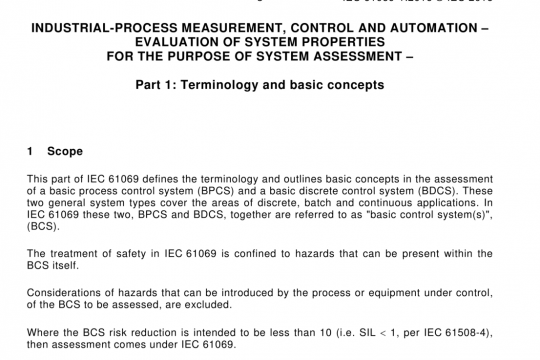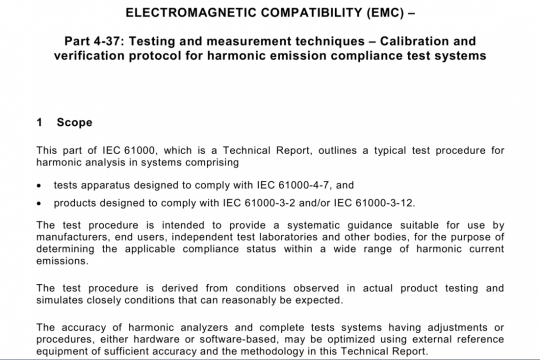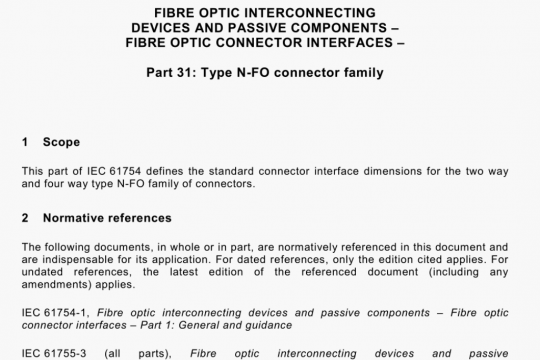EN IEC 63135 pdf free download
EN IEC 63135 pdf free download.Maritime navigation and radiocommunication equipment and systems – Automatic identification systems (AIS) – SAR Airborne equipment – Operational and performance requirements, methods of test and required test results.
4 General requirements
4.1 General
4.1.1 OvervIew
Requirements contained in Clause 4 are requirements not taken up in other clauses and are verified by observation and inspection of documented evidence.
This document specifies the requirements for the AIS SAR airborne station. The AIS SAR airborne station shall support search and rescue operations involving SAR aircraft.
4.1.2 Capabilities of the AIS
The AIS SAR airborne station shall be capable of providing to ships, and to competent authorities, information from the SAR aircraft, automatically and with the required accuracy and frequency, to facilitate accurate tracking. Transmission of the data shall be with the minimum involvement of personnel.
4.1.3 Transmitter shutdown procedure
An automatic transmitter hardware shutdown procedure and indication shall be provided in case a transmitter continues to transmit for more than 2 s. This shutdown procedure shall be independent of software control.
4.2 Modes of operation
The system shall be capable of operating in a number of modes:
1) an “autonomous and continuous” mode for operation in all areas; this mode shall be capable of being switched to/from one of the following alternate modes by a competent authority;
2) an “assigned” mode for operation in an area subject to a competent authority responsible for traffic monitoring such that the data transmission interval and/or time slots may be set remotely by that authority;
3) a “polling” or controlled mode where the data transfer occurs in response to interrogation from a ship or competent authority;
4) a “receive only” mode where the station does not transmit.
5 Performance requirements
5.1 Composition
The AIS SAR airborne station shall comprise (see Annex A):
1) a communication processor, capable of operating over a range of maritime frequencies, with an appropriate channel selecting and switching method;
2) at least one transmitter and two TDMA receiving processes;
3) a means of processing data from an electronic position-fixing system which provides a resolution of one ten thousandth of a minute of arc and uses the WGS 84 datum; an interface (see 6.6.2) may be provided to input the position used for navigation;
4) a means to automatically input data from other sensors meeting the provisions as specified in 5.5.1 2) may be provided;
5) a means of error checking the transmitted and received data (see Clause 6); and
6) built-in test equipment (BITE) as specified in 5.8.1.
The AIS SAR airborne station shall be capable of:
7) providing information automatically and continuously to other AIS stations, without involvement of personnel;
8) receiving and processing information from other AIS stations;
9) responding to high priority and safety related calls with a minimum of delay;
10) providing positional and manoeuvring information at a data rate adequate to facilitate accurate tracking by a competent authority and other AIS stations (see 5.5.2).
5.2 Time and position
5.2.1 Source for UTC
The AIS shall be provided with an internal GNSS receiver as primary UTC source which is
required for synchronisation purposes and for position. COG and SOG.
NOTE UTC includes a provision for leap seconds.
The internal GNSS receiver shall meet appropriate requirements for position accuracy, COG/SOG, acquisition, re-acquisition, receiver sensitivity, RF dynamic range, interference susceptibility, position update, failure warnings, status indications and integrity flag.
If an external source of UTC is provided, it shall fulfil the requirement for synchronization timing.
If date and time is not available and Message 4 or 11 is being received, the unit shall use date and time from that message, and the seconds shall be omitted.
5.2.2 Source for AIS position reporting
The source for position reporting may vary depending on the conditions specified in 5.8.3.4.
When the external position is unavailable, the internal GNSS receiver shall be used as a source for AIS position reporting.
When the internal GNSS receiver is performing as a source for AIS position reporting, an appropriate BITE indication shall be output on the presentation interface (see 5.8.1).
The internal GNSS receiver may be capable of being differentially corrected.
Where DGNSS corrections are received from multiple sources, the DGNSS corrections from the nearest DGNSS reference station should be used taking into account the Z count, and the health of the DGNSS reference station.EN IEC 63135 pdf download.




